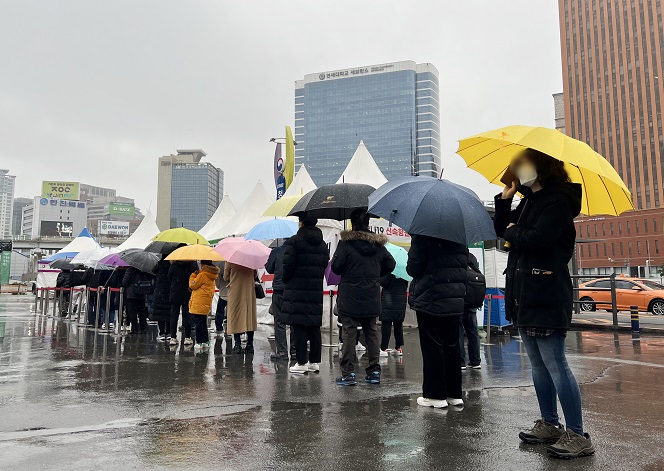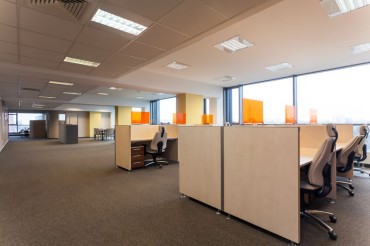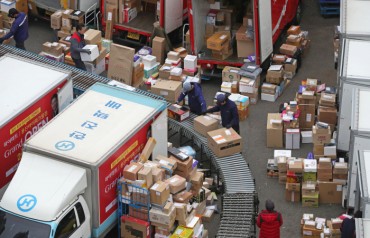
People wait in a long line to receive coronavirus tests at a makeshift COVID-19 testing facility in Seoul on March 19, 2022. The country reported 381,454 new infections on the day. (Yonhap)
SEOUL, March 20 (Korea Bizwire) — South Korea’s new COVID-19 cases dropped below 400,000 for the second straight day on Sunday but concerns remain high that infections could spike again as the government is set to ease social distancing rules this week.
The country reported 334,708 new COVID-19 infections, including 22 from overseas, raising the total caseload to 9,373,646, the Korea Disease Control and Prevention Agency (KDCA) said.
The latest tally was down from the previous day’s daily cases of 381,454. It also marked a sharp drop from the all-time high of 621,281 reported Thursday.
It is still uncertain as to whether daily infections have been trending down, given that cases tend to decline over the weekend due to fewer tests.
The death toll from COVID-19 came to 12,428, up 327 from Saturday. The tally was higher than 319 deaths reported a day earlier and represented the second highest following 429 logged on Thursday. The fatality rate was 0.13 percent.
Senior people took up most of the latest death toll, with those aged 80 or older taking up 66.4 percent. Those in their 60s and 70s also made up 8.3 percent and 21.4 percent, respectively.
The number of critically ill patients stood at 1,033, down from 1,049 tallied the previous day.
As of 9 p.m. Sunday, the country had reported 204,054 cases, down 114,784 from the same time the previous day, according to health authorities and provincial governments. Daily cases are counted until midnight and announced the following morning.
Despite recent letups, concerns lingered that daily infections could spike again as the government is set to ease social distancing rules this week as part of efforts to help small merchants and business owners taking the brunt of the pandemic due to less foot traffic and consumption.
Starting Monday, the government will also ease the limit on private gatherings to eight people from the current six while maintaining the 11 p.m. business curfew.

Officials talk with COVID-19 patients receiving at-home treatment over the phone at a disaster center in Seoul on Feb. 21, 2022, when the cumulative number of such patients surpassed 2 million. (Yonhap)
As the government predicts the omicron spread will likely peak this week, it is considering a further easing of the virus curbs.
Those measures are the latest in a series of steps to ease tough social distancing rules despite the still rampant spread of the highly transmissible omicron variant of the coronavirus.
Since March 1, the government has suspended the enforcement of the vaccine pass system at restaurants and cafes over the lack of staff to handle the mandatory requirement of presenting proof of being vaccinated.
In the face of the surging infections and overwhelmed hospital capacity, the government has also turned its focus away from preventing people from getting infected toward treating seriously ill patients.
It requires most infected people to receive at-home treatment for a week and allows them to come out without presenting their health status, such as polymerase chain reaction (PCR) test results.
The number of people receiving at-home treatment stands at 2,146,951 as of early Sunday, the KDCA said.
Of the domestic cases, Seoul reported 65,870 new infections, with the surrounding Gyeonggi Province logging 88,479. The western port city of Incheon reported 19,149.
Those aged 60 or older, deemed to be a highly at-risk age group, accounted for 20.3 percent, with those aged 18 or younger making up 25.2 percent.
As of Saturday, 32.37 million people out of the 52 million population, or 63.1 percent, had received booster shots. Fully vaccinated people came to 44.46 million, representing 86.6 percent, the KDCA said.
(Yonhap)






